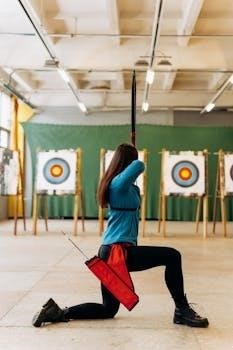zen the art of archery pdf

Zen in the Art of Archery PDF⁚ An In-Depth Exploration
Eugen Herrigel’s “Zen in the Art of Archery” explores the connection between Zen and Kyudo, Japanese archery. The book, widely read, delves into Herrigel’s personal experience and training, offering a unique perspective on Zen principles. It examines not just the mechanics of archery, but the deep meditative process involved.
Eugen Herrigel, a German philosophy professor, penned “Zen in the Art of Archery,” a seminal work that has captivated readers since its publication in 1948. This book isn’t merely a manual on the techniques of Japanese archery, known as Kyudo; rather, it’s a profound exploration of the intersection between Zen philosophy and a physical discipline. Herrigel’s work provides a unique lens through which to understand Zen, moving beyond abstract concepts to a practical, embodied experience. His journey began when he lived in Japan in the 1920s, where he sought a deeper understanding of Zen and chose Kyudo as a path to enlightenment. He didn’t approach archery as a mere sport, but as a way to embody and integrate Zen principles into his being. Herrigel’s narrative is not just about mastering the bow, but about mastering the self. The book details his rigorous training and the challenges he faced, offering a compelling narrative that bridges Eastern philosophy and Western thought. It’s a personal account that resonates with many seeking meaning and a deeper connection to their inner selves. Herrigel’s work has been widely interpreted as a study of Japanese culture, though it also reveals the mythical nature of Zen and the transformative process one can undergo through dedicated practice.
The Core Concept of Zen in Archery

The core concept of Zen in archery, as presented by Herrigel, transcends the mere act of hitting a target. It’s about achieving a state of “mushin,” or “no-mind,” where the archer acts without conscious thought or intention. This is not about abandoning skill or technique, but about integrating them so deeply that they become intuitive and effortless. The focus shifts from the goal of hitting the bullseye to the process itself. The archer aims to be in perfect harmony with the bow, the arrow, and the target, allowing the shot to release naturally, without any interference from the ego. It’s a practice that cultivates mindfulness, requiring complete presence in the moment. The archer becomes a conduit for the arrow, not its controller. This state of “no-mind” is not a void but rather a state of heightened awareness and receptivity. It’s about letting go of the self-conscious striving for success and surrendering to the flow of action. The challenge lies in overcoming the ego’s tendency to control and judge, allowing the inherent wisdom of the body to guide the process. In essence, Zen in archery is a path of self-discovery, where the bow becomes a tool for inner transformation.
Kyudo as a Path to Zen
Kyudo, the Japanese art of archery, is presented not just as a sport or martial art but as a profound path to Zen enlightenment. The practice of Kyudo emphasizes precision, grace, and inner stillness, mirroring the core tenets of Zen Buddhism. Each element of the practice, from the way the archer holds the bow to the final release of the arrow, is imbued with meditative significance. The meticulous rituals and forms of Kyudo are designed to cultivate a state of mindfulness and presence. The focus is not solely on hitting the target but on refining the archer’s inner state. The slow, deliberate movements of Kyudo encourage a deep connection between mind and body. By immersing themselves in the practice, archers begin to experience a union of self and action. The struggle to master the techniques is a metaphor for the struggle to overcome the ego’s limitations. Through rigorous training, the archer learns to let go of the need for control, allowing the shot to arise spontaneously from a place of inner harmony. Kyudo becomes a vehicle for self-discovery, leading to a deeper understanding of the self and the interconnectedness of all things. The path to Zen through Kyudo is not about achieving perfection but about embracing the process with patience, humility, and unwavering dedication.
Herrigel’s Experience in Japan
Eugen Herrigel’s sojourn in Japan during the 1920s was not merely a cultural immersion; it was a profound spiritual quest. He was drawn to Japan seeking an understanding of Zen, a path that he believed could be accessed through the practice of Kyudo. His time in Japan was marked by a rigorous dedication to the art of archery under the tutelage of a master. Herrigel’s narrative is not a straightforward account of skill acquisition; instead, it’s a detailed exploration of the challenges and transformations he faced. He encountered cultural differences, linguistic barriers, and the demanding nature of traditional training methods. His experiences were filled with moments of frustration and self-doubt, as he grappled with the seemingly paradoxical principles of Zen. The emphasis on inner stillness and letting go challenged his Western analytical mindset. He struggled to understand the concept of “it” shooting, where the shot arises not from conscious effort but from a state of non-thinking. Herrigel’s journey was a process of unraveling his preconceived notions and opening himself to the wisdom of Japanese culture. His account provides valuable insights into the cultural context of Zen practices and the challenges of bridging different philosophical traditions. Through his experience, readers can glimpse the potential of Kyudo as a path to self-discovery.
Training with Awa Kenzo
Eugen Herrigel’s training under the guidance of Awa Kenzo, a renowned Kyudo master, formed the core of his transformative journey. Awa Kenzo was not merely an archery instructor; he was a master of Zen principles who used the practice of Kyudo as a vehicle for spiritual development. Herrigel’s account highlights the demanding nature of the training, which extended far beyond the technicalities of archery. Awa Kenzo emphasized the importance of inner stillness, correct posture, and the cultivation of a meditative state of mind. The training involved numerous repetitions of the basic forms, not to perfect the technique but to transcend the mechanical. Awa Kenzo’s approach was often enigmatic, using silence, gestures, and subtle cues to guide Herrigel. He pushed Herrigel to move beyond conscious effort and to allow the shot to arise spontaneously from a place of emptiness. The master’s teachings were often paradoxical, challenging Herrigel’s rational mind and forcing him to confront the limits of his understanding. The training was not just about hitting the target; it was about letting go of the ego and realizing a deeper connection with the act itself. Awa Kenzo’s influence shaped Herrigel’s understanding of Zen and its application to the art of archery, making it a spiritual practice. His guidance is considered very inspirational.
The Mythical Nature of Zen in the Art of Archery
The concept of Zen as portrayed in “Zen in the Art of Archery” has often been described as having a mythical quality, primarily due to the way Eugen Herrigel presents his experiences. Some scholars argue that Herrigel’s interpretation of Zen is heavily influenced by his own preconceptions and expectations, rather than a purely objective account. The book’s narrative leans into the mysterious and esoteric, portraying Zen as an almost unattainable state of being that can only be reached through rigorous and often perplexing training. This portrayal has contributed to the romanticized and sometimes inaccurate understanding of Zen in Western cultures. The emphasis on the “it” and the spontaneous release of the arrow, which seems to bypass conscious control, often appears more mystical than practical. Critics point out that Herrigel’s account can be seen as a selective interpretation that emphasizes certain aspects of Zen while overlooking others. The text tends to elevate Awa Kenzo’s teachings to an almost supernatural level, further contributing to the mythical aura surrounding the practice. The book’s enduring popularity rests partially on its ability to tap into the human desire for transcendence, but it’s important to approach it with a critical awareness of its potential embellishments and inherent biases.
Key Themes and Ideas
Several key themes and ideas are central to Eugen Herrigel’s “Zen in the Art of Archery.” The most prominent theme is the concept of “mushin,” or no-mind, which describes a state of being where actions arise spontaneously without conscious thought or intention. This is closely tied to the idea of letting go, both in archery and in life. The book explores the process of mastering a skill not through deliberate effort but through a kind of passive receptivity to the task at hand. Another central theme is the importance of the teacher-student relationship, highlighted by Herrigel’s interactions with Awa Kenzo. The idea of the “right” way, not just in physical action but in mental attitude, also features heavily. The narrative emphasizes that achieving proficiency in archery is not just about physical skill but also about cultivating the right mental state. The book also examines the idea of the self, suggesting that mastery comes from dissolving the ego and allowing action to flow through the individual. Herrigel’s work touches on the interplay between inner and outer realities, suggesting that true mastery involves aligning the inner self with external actions. The book’s overall message is that the path to spiritual enlightenment can be found through the dedicated practice of a physical discipline.
Mindfulness and Meditation in Archery

Mindfulness and meditation are not just abstract concepts within Zen; they are intrinsic to the practice of archery as described in “Zen in the Art of Archery.” The book emphasizes that archery is not merely a physical activity, but a form of moving meditation. The archer’s focus is not solely on hitting the target, but on the present moment. Each action, from drawing the bow to releasing the arrow, is performed with full awareness. This cultivates a state of mindfulness, where the archer is fully present in the body and the mind. The process of archery serves as a tool for meditation, helping to quiet the incessant chatter of the mind. By engaging in the repetitive actions with total concentration, the archer can achieve a state of mental stillness. This focus transcends the goal of hitting the bullseye, becoming an experience of pure presence. The book portrays archery as a means of self-discovery, where the discipline of mindfulness allows the archer to understand their own mental and emotional patterns. The meditative aspect of archery helps to foster an inner calm and clarity, which can then be applied to other aspects of life. The practice demands a merging of the archer’s consciousness with the act of archery itself, highlighting the profound connection between mind, body, and spirit.
The Balance Between Body and Mind
The core of “Zen in the Art of Archery” lies in the crucial balance between the body and mind, a concept central to Zen philosophy. The book demonstrates that archery is not purely a physical skill, but rather a harmonious interplay between physical action and mental focus. The archer’s body must be trained to execute the movements with precision, but the mind must be equally disciplined to maintain a calm, centered state. This is not about brute strength or forceful action, but about achieving a state of effortless flow, where the body moves naturally and efficiently. The mind, in turn, must be free from distractions and anxieties. The archer’s mind is not focused on the outcome of hitting the target, but on the process of executing the shot. A balanced approach means that the body and mind must work in unison. One cannot achieve success in archery, nor in life, if either aspect is neglected. The archer is encouraged to cultivate an inner stillness that allows the body to move naturally, in accordance with the principles of the practice. This balance between body and mind is not merely a technique, but a way of being. It is a path to self-discovery, revealing the interconnectedness of all aspects of human experience.

The “It” and the Art of Letting Go
A central concept in “Zen in the Art of Archery” is the idea of “It,” which represents the spontaneous action that arises when the archer’s mind and body are perfectly aligned. This “It” is not a conscious decision or a forced action, but a natural flow of energy that occurs when the archer has fully surrendered to the process. The art of letting go is crucial to achieving this state. The archer must release their ego and their desire to control the outcome. The mind must not interfere with the natural flow of the body, and instead allow the action to unfold organically. This surrender is not passivity, but a powerful act of trust in the inherent wisdom of the body. The archer must learn to let go of their attachment to the target, to the idea of success and failure. They must instead focus on the present moment, on the process of drawing the bow and releasing the arrow. This letting go is the key to unlocking the power of “It,” allowing the arrow to fly with precision and grace. This requires a deep understanding of the interconnectedness of all things, an awareness that the archer is not separate from the bow, the arrow, or the target.
Criticism and Analysis of Herrigel’s Work

Eugen Herrigel’s “Zen in the Art of Archery” has faced considerable criticism, with some scholars questioning the accuracy of his portrayal of Zen and Kyudo. Some argue that his experiences and interpretations were filtered through a Western lens, leading to a romanticized and possibly inaccurate understanding of Japanese culture. Critics point out that Herrigel’s focus on the mystical and spiritual aspects of archery may have overshadowed the more practical and technical elements of the discipline. The book has been accused of presenting a simplified and idealized version of Zen, potentially misrepresenting its complexities. Furthermore, some scholars suggest that Herrigel’s account lacks historical context, failing to fully acknowledge the cultural and social influences on Kyudo. There is debate regarding the extent to which Herrigel’s experience was a reflection of genuine Zen practice or a personal interpretation of it. Some claim that he may have projected his own philosophical beliefs and desires onto the practice. The book’s popularity has also led to concerns about the potential for cultural appropriation and misrepresentation. Despite these criticisms, Herrigel’s work remains a significant contribution to the popular understanding of Zen and its potential application to various activities. It has sparked interest in the practice of mindfulness and the interconnectedness of body and mind.
Availability of Zen in the Art of Archery PDF
The “Zen in the Art of Archery” PDF is widely available across various online platforms, catering to those seeking digital access to Eugen Herrigel’s influential work. Many reputable sources offer the PDF for download, both free of charge and through purchase. Open Library, for instance, is a reliable source, providing access to a vast collection of eBooks, including “Zen in the Art of Archery.” University libraries and academic databases also frequently host the PDF, facilitating access for students and researchers. Amazon, while primarily known for selling physical copies, sometimes offers digital versions as well. Websites specializing in literature and philosophy may also provide download links. It is essential to verify the legitimacy and safety of the source before downloading any PDF to avoid malware or copyright infringement. Some online platforms may offer free versions, while others may require a purchase. The ease of access to the digital version of this book has contributed to its widespread readership and continued relevance in contemporary discussions on Zen and mindfulness. The availability of the PDF format ensures that Herrigel’s work continues to be accessible to a global audience, irrespective of geographical location or access to physical bookstores. This broad availability enables individuals to delve into the teachings and philosophical concepts presented within the book.